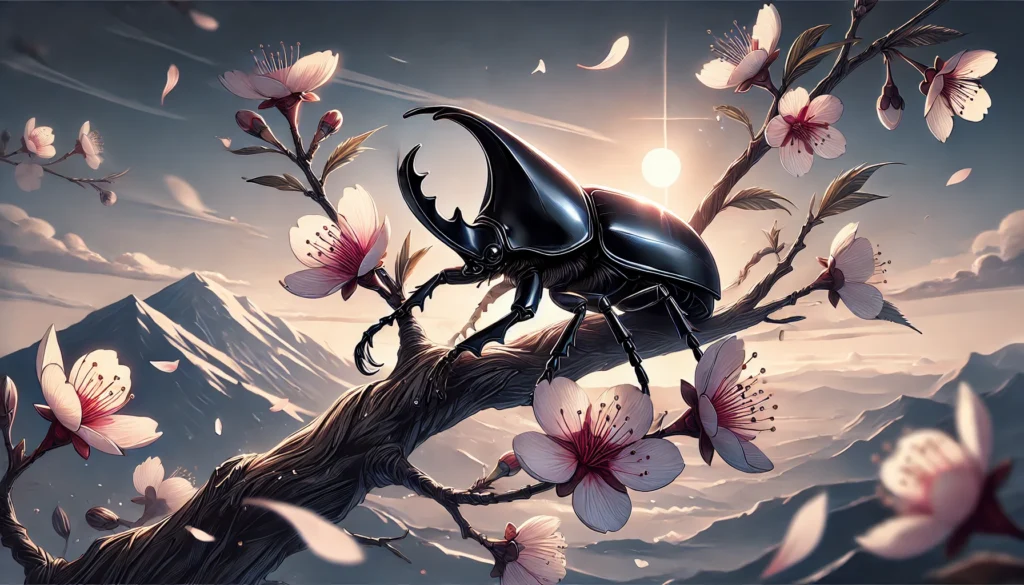Have you ever wandered through a Japanese garden and spotted a beautiful butterfly, only to wonder what it’s called in Japanese? Or perhaps you’ve encountered a curious beetle during your travels in Japan and wished you knew its local name? This Ultimate Japanese Insects List: Butterflies, Beetles & More will help you identify and understand the fascinating creatures you encounter throughout Japan.
Understanding Japanese insects and their native names not only enhances your nature appreciation but also offers fascinating insights into Japanese culture and language. Japan’s rich biodiversity includes thousands of insect species, each with unique Japanese names that often poetically describe their appearance or behavior. This comprehensive Japanese insects list will introduce you to common and remarkable insects found throughout the Japanese archipelago, from the northern island of Hokkaido to the subtropical Okinawa.
Want to start learning Japanese right away?
Access our Free Study Guides with grammar explanations, vocabulary lists, and study tips. All at no cost.
Why Learn Japanese Insect Names?
Learning insect names in Japanese can be valuable for several reasons:
- Cultural appreciation: Many insects hold special significance in Japanese art, literature, and folklore
- Language learning: Insect names provide interesting vocabulary that reveals naming patterns in Japanese
- Travel enhancement: Identify local wildlife during your trips to Japan
- Scientific interest: Understanding Japanese taxonomy adds another dimension to entomology studies
- Conversation skills: Discuss nature topics with Japanese speakers using appropriate terminology
Common Butterflies and Moths in Japan (チョウとガ)
Swallowtail Butterflies (アゲハチョウ)
The swallowtail family includes some of Japan’s most beautiful butterflies. Their Japanese name “Ageha” is often used as a poetic way to refer to butterflies in general.
- Japanese Yellow Swallowtail (ナミアゲハ, Nami-ageha)
- Scientific name: Papilio xuthus
- Distinctive features: Yellow with black stripes and blue/red spots
- Cultural note: One of the most common and beloved butterflies in Japan
- Chinese Peacock (カラスアゲハ, Karasu-ageha)
- Scientific name: Papilio bianor
- Distinctive features: Dark wings with metallic blue-green areas
- Literal translation: “Crow swallowtail” due to its dark coloration
- Great Mormon (ナガサキアゲハ, Nagasaki-ageha)
- Scientific name: Papilio memnon
- Distinctive features: Large size, black wings, multiple forms
- Distribution note: Found primarily in southern Japan
Other Notable Butterflies
- Indian Fritillary (ツマグロヒョウモン, Tsumaguro-hyoumon)
- Scientific name: Argynnis hyperbius
- Distinctive features: Orange with black spots, females have white patches
- Cultural significance: Recently expanded its range throughout Japan
- Japanese Emperor (オオムラサキ, Oomurasaki)
- Scientific name: Sasakia charonda
- Distinctive features: Purple-blue iridescence on dark wings
- Status: Japan’s national butterfly, designated as a protected species
Distinctive Moths
- Japanese Silk Moth (シンジュサン, Shinju-san)
- Scientific name: Samia cynthia
- Distinctive features: Large brown moth with crescent moon patterns
- Historical significance: Related to silkworm production
- Green Hawk Moth (ウンモンスズメ, Unmon-suzume)
- Scientific name: Callambulyx tatarinovii
- Distinctive features: Camouflage green and brown coloration
- Name origin: “Suzume” means sparrow, referring to the hovering flight
- Firefly Moth (ホタルガ, Hotaru-ga)
- Scientific name: Pidorus atratus
- Distinctive features: Black with white stripes and red head
- Naming note: Despite its name, it doesn’t produce light like true fireflies

Beetles of Japan (甲虫)
Japan has a remarkable diversity of beetles, many of which are collected and kept as pets, especially by children during summer.
Stag Beetles (クワガタムシ)
- Japanese Stag Beetle (ノコギリクワガタ, Nokogiri-kuwagata)
- Scientific name: Prosopocoilus inclinatus
- Distinctive features: Large mandibles resembling saw teeth
- Cultural note: Popular as pets and in collection among Japanese children
- Giant Stag Beetle (オオクワガタ, Oo-kuwagata)
- Scientific name: Dorcus hopei
- Distinctive features: Massive size, powerful mandibles
- Status: One of the most prized beetle species for collectors
Ladybugs (テントウムシ)
- Seven-spotted Ladybug (ナナホシテントウ, Nanahoshi-tentou)
- Scientific name: Coccinella septempunctata
- Distinctive features: Red with seven black spots
- Name origin: “Nanahoshi” means “seven stars,” referring to its spots
- Yellow Ladybug (キイロテントウ, Kiiro-tentou)
- Scientific name: Illeis koebelei
- Distinctive features: Yellow body with variable markings
- Ecological note: Feeds primarily on mildew, beneficial to plants
Other Remarkable Beetles
- Japanese Rhinoceros Beetle (カブトムシ, Kabutomushi)
- Scientific name: Allomyrina dichotoma
- Distinctive features: Large horn on head resembling a samurai helmet
- Cultural significance: Symbols of strength, popular summer pets
- Jewel Beetle (タマムシ, Tamamushi)
- Scientific name: Chrysochroa fulgidissima
- Distinctive features: Metallic, iridescent coloration
- Historical note: Used in traditional Japanese art and decorative objects
- Longhorn Beetle (カミキリムシ, Kamikiri-mushi)
- Scientific name: Various species in Cerambycidae family
- Name origin: “Kamikiri” means “hair-cutter,” referring to their strong jaws
- Note: Over 800 species in Japan, many with distinctive patterns
- Japanese Weevil (ゾウムシ, Zoumushi)
- Scientific name: Various species in Curculionidae family
- Name origin: “Zou” means elephant, referring to the snout-like rostrum
- Cultural note: “Big Weevil” (オオゾウムシ, Oo-zoumushi) is Japan’s largest
Dragonflies and Damselflies (トンボ)
Dragonflies hold special significance in Japanese culture as symbols of courage, strength, and summer.
- Red Dragonfly (アキアカネ, Aki-akane)
- Scientific name: Sympetrum frequens
- Cultural significance: Featured in many poems and songs about autumn
- Seasonal association: A symbol of fall in Japan
- Black Damselfly (ハグロトンボ, Haguro-tonbo)
- Scientific name: Calopteryx atrata
- Distinctive features: Metallic black wings
- Habitat: Found near clean, flowing streams
True Bugs (カメムシ類)
- Stink Bug (カメムシ, Kamemushi)
- Scientific name: Various species
- Name origin: “Kame” means turtle, referring to their shell-like appearance
- Cultural note: Known for their distinctive smell when disturbed
- Yellow-spotted Stink Bug (キマダラカメムシ, Kimadara-kamemushi)
- Scientific name: Erthesina fullo
- Distribution: Common in urban areas throughout Japan
- Distinctive features: Brown with yellow mottled pattern
- Jewel Stink Bug (アカスジキンカメムシ, Akasuji-kin-kamemushi)
- Scientific name: Poecilocoris lewisi
- Distinctive features: Metallic green and red coloration
- Development: Nymphs are distinctive black and white
Love Japan? Stay in the Loop!
Hi, I’m Jesse! Join 100+ learners and get my best Japanese learning tips straight to your inbox.
Other Notable Japanese Insects
Mantises and Stick Insects
- Japanese Mantis (カマキリ, Kamakiri)
- Scientific name: Tenodera aridifolia
- Name origin: “Kama” refers to a sickle, describing its forelegs
- Cultural significance: Considered beneficial for controlling pests
- Stick Insect (ナナフシ, Nanafushi)
- Scientific name: Various species including Entoria okinawaensis
- Cultural note: In Okinawan folklore, believed to be “horses” for gods
- Japanese name meaning: “Seven joints,” referring to their segmented body
Bees and Wasps
- Japanese Giant Hornet (オオスズメバチ, Oo-suzumebachi)
- Scientific name: Vespa mandarinia japonica
- Distinctive features: Extremely large size, powerful sting
- Cultural impact: Feared but respected in rural Japan
- Cuckoo Wasp (セイボウ, Seibou)
- Scientific name: Stilbum cyanurum
- Distinctive features: Brilliant metallic blue or green
- Behavior note: Parasitizes other wasp nests
Flies and Mosquitoes
- Robber Fly (アブ, Abu)
- Scientific name: Various species in Asilidae family
- Distinctive behavior: Predatory, catches other insects in mid-air
- Local name: “Salt Merchant Horsefly” (シオヤアブ, Shioya-abu)
- Tiger Mosquito (ヒトスジシマカ, Hitosuji-shimaka)
- Scientific name: Aedes albopictus
- Distinctive features: Black with white stripes
- Health significance: Vector for several diseases
Seasonal Insects in Japanese Culture
Many insects in Japan are strongly associated with specific seasons, appearing in seasonal poetry and art.
Summer Insects (夏の虫)
- Firefly (ホタル, Hotaru)
- Scientific name: Luciola cruciata and others
- Cultural significance: Symbol of summer, featured in many poems
- Conservation: Special riverside viewing areas protected for fireflies
- Cicada (セミ, Semi)
- Scientific name: Various species including Platypleura kaempferi
- Cultural impact: Their song is the soundtrack of Japanese summer
- Varieties: Different species emerge at different points in summer
Autumn Insects (秋の虫)
- Bell Cricket (スズムシ, Suzumushi)
- Scientific name: Meloimorpha japonica
- Cultural significance: Traditionally kept for their pleasant chirping
- Poetic association: Symbol of autumn in classical Japanese literature
- Pine Cricket (マツムシ, Matsumushi)
- Scientific name: Xenogryllus marmoratus
- Cultural practice: Historically kept in special cages for their song
- Seasonal reference: Common autumn seasonal word in poetry
Household Insects in Japan
- Silverfish (シミ, Shimi)
- Scientific name: Lepisma saccharina
- Habitat: Found in older Japanese buildings
- Behavior: Feeds on paper and other carbohydrates
- Black Carpet Beetle (ヒメマルカツオブシムシ, Hime-maru-katsuobushi-mushi)
- Scientific name: Attagenus unicolor
- Habitat: Found in closets and storage areas
- Management: Common but generally harmless in small numbers

Japanese Insect Watching and Conservation
Japan has a long tradition of insect appreciation, from the ancient practice of keeping singing insects to modern conservation efforts.
Popular Insect Watching Locations
- Shinjuku Gyoen National Garden (Tokyo): Butterfly watching in spring and summer
- Yoyogi Park (Tokyo): Various insects including stag beetles
- Hotaru no Sato (Various locations): Firefly viewing spots throughout Japan
- Kibogaoka Ecological Park (Yokohama): Butterfly gardens and insect habitats
Conservation Status
Many Japanese insects face threats from habitat loss, climate change, and invasive species. Several organizations work to monitor and protect vulnerable populations:
- The Japanese Society of Conservation Biology maintains red lists of endangered insect species
- Local “Satoyama” conservation initiatives preserve traditional landscapes that support diverse insect populations
- Citizen science projects engage the public in monitoring insect populations throughout Japan
Learning Resources for Japanese Insect Enthusiasts
This Ultimate Japanese Insects List: Butterflies, Beetles & More is just the beginning of your entomological journey in Japan. If you’re interested in learning more about Japanese insects and their names, consider these additional resources:
- Japanese Insect Field Guides: Several illustrated guides are available in bookstores throughout Japan
- Museum Collections: The National Museum of Nature and Science in Tokyo has extensive insect exhibitions
- Online Communities: Japanese entomology forums welcome international participants
- Language Learning Tools: Our guides like Counting to 100 in Japanese and JLPT N5 Kanji Cheat Sheet can help you master the Japanese terminology
For travelers to Japan interested in wildlife, our article on The Japanese Countryside provide valuable information about seasonal activities, including the best times for insect observation in different parts of the country.
Practical Tips for Observing Insects in Japan
- Seasonal planning: Research which insects are active during your visit
- Location research: National parks and botanical gardens offer excellent insect viewing
- Equipment: A small magnifying glass and camera with macro capability are helpful
- Etiquette: Observe without disturbing habitats or collecting protected species
- Weather considerations: Many insects are most active on warm, sunny days

Frequently Asked Questions about Japanese Insects
What is the national insect of Japan?
The Japanese rhinoceros beetle (カブトムシ, Kabutomushi) is considered the unofficial national insect of Japan, while the Japanese emperor butterfly (オオムラサキ, Oomurasaki) is the official national butterfly.
Are there dangerous insects in Japan?
Yes, the Japanese giant hornet (オオスズメバチ, Oo-suzumebachi) can be dangerous with a painful sting that requires medical attention. However, fatalities are rare and most insects in Japan are harmless to humans.
What Japanese insects are popular as pets?
Stag beetles (クワガタムシ, Kuwagata-mushi) and rhinoceros beetles (カブトムシ, Kabutomushi) are extremely popular as children’s pets during summer. Singing insects like bell crickets (スズムシ, Suzumushi) were traditionally kept for their pleasant sounds.
When is the best time to see fireflies in Japan?
Late May to early July is typically the best time to see fireflies in Japan, with peak viewing periods varying by region. Special firefly viewing events are held throughout the country.
What do Japanese cicadas sound like?
Different species of Japanese cicadas produce distinct sounds. The large brown cicada (アブラゼミ, Abura-zemi) makes a continuous buzzing sound, while the evening cicada (ヒグラシ, Higurashi) produces a more melodic, wistful sound associated with late summer.

Conclusion: The Enduring Fascination with Japanese Insects
The rich diversity of insects in Japan has long captivated both naturalists and cultural enthusiasts. From the seasonal songs of cicadas to the brilliant flashes of fireflies, Japanese insects are deeply woven into the country’s cultural fabric and natural heritage.
This Japanese insects list provides just a glimpse into the fascinating world of Japanese entomology. Whether you’re planning a trip to Japan, studying the language, or simply interested in biodiversity, the insects of Japan offer endless opportunities for discovery and appreciation. We hope this Ultimate Japanese Insects List has inspired you to look more closely at these fascinating creatures during your next visit to Japan.
By learning this Japanese insects list, you not only expand your vocabulary but also gain insight into how Japanese culture perceives and categorizes the natural world—revealing connections between language, nature, and human experience that transcend cultural boundaries.
Ready to enhance your Japanese language skills? Download our free guides: Essential Japanese Phrases, Hiragana & Katakana Cheat Sheet, and more to complement your nature vocabulary!
Connect with Fellow Japanese Learners!
Ask questions, get study tips, and take part in weekly challenges. Join a community of motivated learners exploring both the language and culture of Japan!




